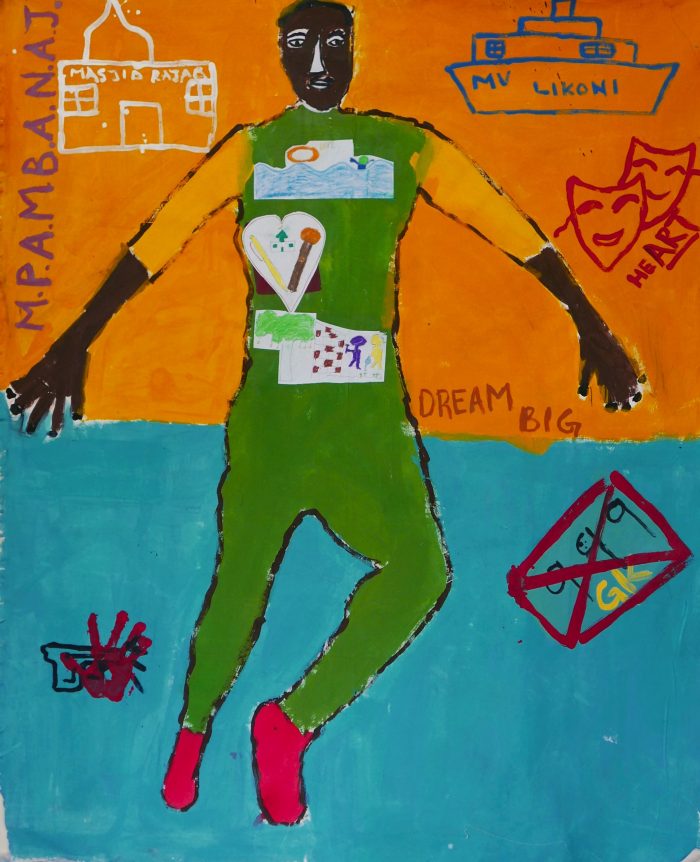Malenga 001
Mpambanaji
On the inner part of my painting, I have used green because it signifies I am only human. On the top part of my hands, I used yellow because I believe I have the ability to enlighten and bring light onto people’s lives with my talents. I have painted my feet red because I want to leave footsteps of love wherever I go.
The lower background is blue. This is the sea in Mombasa. The upper background part is yellowish orange to signify light. There is still light at the end of the tunnel – don’t let yourself drown – but you should look at the opportunities that can make you triumph. I wrote MPAMBANAJI in Swahili. This means that I am a fighter and a conqueror. I think everybody out here is fighting their own battle and we should keep on fighting – positively not violently – for change and opportunities.
There is a drawing of MV Likoni on top of my painting because that’s where I live. There is a mosque there as well because I belong to the Muslim community.
On the lower part of the body-map, I drew a gun and a hand on top of it because I resist the juvenile gangs, killings and violence. I also wrote 999 and GK to represent the Kenyan Police and the government of Kenya. This is about police brutality and marginalisation.
Inside the body map, I drew someone drowning. Just a few metres from him is a floater. He is trying to make it to the floater. What keeps him alive is hope. That is why I have used the word ‘HOPE’. I commute using the ferry every day. These vessels are really old and dangerous. What really keeps us alive or keeps us going on every day back and forth is just hope, hoping that we will come home safe. This is about marginalisation, which is a big contributor to violent extremism.
I also drew a heart inside the body map, with microphone, a pen, and a mosque inside it. I use these tools every day as an artist and a poet. I am an actor and I am proud of it. I use art to resist violent extremism. Those are the things that I really feel inside my heart and that I depend on. Wherever I am sad or depressed, I pray. In Likoni, I feel attached to a certain mosque because it is youth-led. There are others mosques that are not youth-friendly. In Islam, the Prophet taught us that when someone is in the wrong, you advise but some mosques do not advise but rather criticise young people.
I also drew a big tree, a very tall wall and two people; one has a hammer and another, with a sprinkler, is watering a plant. This big tree symbolises job opportunities that we as people in Likoni do not get. This wall denotes tribalism, marginalisation and all the problems we undergo. The man with the hammer represents the people getting into the violent extremism, like terror gangs, Al-Shabaab and others. If you try to break the wall, those people (extremists) will come for you. I am the person with a sprinkler. With a few seeds, I can grow my own tree and create my own opportunities. What I am trying to say is that each one of us with our own little abilities can grow our own trees. So, this is how I resist violent extremism.
Art can do a lot, because it speaks the unspoken. I have really liked how this work was interactive. People opened up, people learned from other people, a lot of diversity, different tribes, and different geographical backgrounds. This was very enlightening for me.
My message to the outside world is that “It doesn’t matter where you come from, just find it within yourselves”. I believe everyone in the smallest possible way is talented. They are able to bring change to their community or society. So, just find it within yourselves to contribute towards change in the community or society to resist any form of violence.

